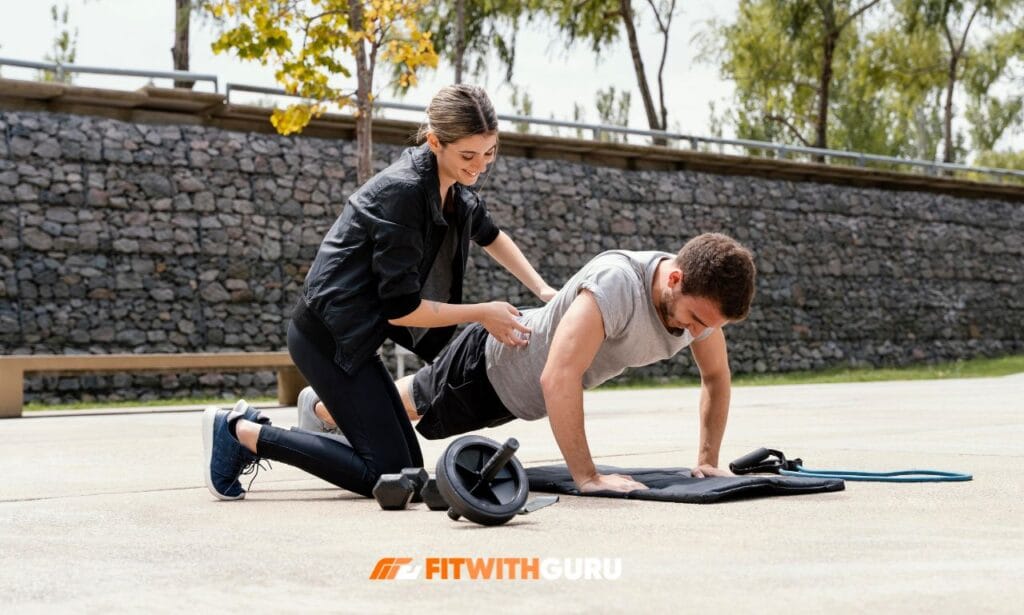Marathon training with strength training has revolutionized how runners approach their 26.2-mile journey. Elite marathoners now combine cardiovascular endurance with targeted strength work to enhance performance and prevent injuries.
This approach addresses muscle imbalances that develop from repetitive running motion and builds the resilient body needed for marathon success. Modern research shows that runners who ignore strength work face higher injury rates and plateau in performance improvements.
Why Marathon Training with Strength Training Works
Marathon training with strength training isn’t just a trend—it’s scientifically proven to improve running economy by 4-8%. When you run repetitively for hours, specific muscle groups become imbalanced while others weaken.
Your posterior chain lags as your calves overdevelop, glutes weaken, and hip flexors tighten. Strength training creates structural integrity to maintain proper form throughout the entire race.
Research shows runners incorporate strength work experience 30-50% fewer injuries and maintain pace better in late-race miles. The key lies in understanding that marathon running demands more than cardiovascular fitness—it requires muscular resilience.
| Benefit | Improvement |
| Running Economy | 4-8% Better |
| Injury Rate | 30-50% Reduction |
| Late-Race Performance | Maintained Pace |
Method 1: Foundation Strength Training
Marathon training with strength training begins with mastering basic movement patterns that address common runner weaknesses.
Focus on bodyweight exercises before progressing to heavier variations to build proper movement quality. This foundation phase typically lasts 4-6 weeks and emphasizes form over intensity.

How to Perform Foundation Training:
- Bodyweight Squats: 3 sets x 15-20 reps (develop quad and glute strength).
- Single-leg Glute Bridges: 3 sets x 12 reps per leg (activate posterior chain).
- Push-ups: 3 sets x 10-15 reps (strengthen neglected upper body).
- Single-leg Deadlifts: 3 sets x 8 reps per leg (build balance and posterior strength).
- Plank: 3 sets x 30-60 seconds (create core stability). Side Planks: 2 sets x 20-30 seconds per side.
Perform 2-3 times weekly during the base-building phase when running volume is moderate. Focus on perfect form over speed or intensity—each rep should be controlled and deliberate. To optimize adaptation, provide a rest period of 24 to 48 hours in between sessions.
Method 2: Power Development Through Plyometrics
Marathon training with strength training reaches new heights with explosive power training that develops reactive strength. Plyometrics improve your ability to generate force quickly during each foot strike, directly enhancing stride efficiency.
Each foot strike during a marathon requires rapid force production—the faster you generate force, the more energy you preserve.
How to Perform Plyometric Training:
Beginner Phase (Weeks 1-2):
- Squat Jumps: 3 sets x 6 reps (focus on soft landings).
- Standing Long Jump: 3 sets x 5 reps (emphasize horizontal power).
- Jump Rope: 3 sets x 30 seconds (develop foot speed and coordination).
Intermediate Phase (Weeks 3-4):
- Hops on one leg: 3 sets x 5 repetitions per leg (develop unilateral power).
- To improve side-to-side stability, perform 3 sets of 8 repetitions in each direction for the lateral bounds.
- Knee Drive Box Step-ups: 3 sets x 6 reps each leg (power specific to running).
Advanced Phase (Weeks 5-6):
- Depth Jumps: 3 sets x 4 reps (maximum reactive strength).
- Single-leg Lateral Hops: 3 sets x 6 reps per leg (advanced unilateral power).
- Hurdle Hops: 3 sets x 5 barriers (complex multi-directional power).
Perform when fresh, ideally 24-48 hours before hard running workouts to optimize neuromuscular readiness. Always prioritize landing mechanics and controlled deceleration over jump height.
Integration Tips
Schedule plyometric sessions strategically to avoid excessive fatigue before quality running workouts. Reduce volume by 30-40% during peak training weeks when running mileage is highest. Your legs should feel springy and responsive after these sessions, not heavy and fatigued.
Elite marathoner Galen Rupp revolutionized American distance running partly through extensive plyometric training. His ability to maintain fast turnover and powerful stride in late marathon stages demonstrates the value of power development.
Never perform high-intensity plyometrics immediately before or after hard running sessions. The explosive nature requires full neuromuscular recovery to be both effective and safe.
Method 3: Hill Training with Resistance Work
Marathon training with strength training finds perfect synergy in hill-based workouts. Hill running forces muscles to work against gravity while maintaining running-specific movement patterns.
How to Perform Hill Training:
1 Phase (Weeks 1-3):
- Easy hill runs: 20-30 minutes at a conversational pace. Grade: 3-5%. Focus: Building form and base strength
Phase 2 (Weeks 4-6):
- Hill tempo runs: 3-4 x 8-10 minutes at comfortably hard effort. Grade: 4-6%. Recovery: 2-3 minutes easy jogging downhill
Phase 3 (Weeks 7-9):
- Hill intervals: 6-8 x 2-3 minutes at 5K pace effort. Grade: 6-8%. Recovery: Equal time easy jogging
Include controlled downhill running for eccentric strength development.
Method 4: Core Stability Training
Marathon training with strength training must prioritize core stability as the foundation for efficient mechanics .With every step, your core distributes stresses between your upper and lower body.
How to Perform Core Stability Training:
Foundation Phase:
- Dead Bug: 10 reps per side, 3 sets.
- Bird Dog: 5-second holds for 3 sets of 8 reps per side.
- Pallof Press: 3 sets x 12 reps per side. Single-leg Stand: 3 sets x 30 seconds per leg.
Development Phase:
- One-leg Three sets of eight reps per leg is the Romanian deadlift.
- Plank to Push-up: 3 sets x 8 reps.
- Turkish Get-up: 2 sets x 3 reps per side. Bear Crawl: 3 sets x 20 steps.
Progress from static holds to dynamic movements that challenge stability during motion.
Method 5: Recovery Strength Training
Marathon training with strength training must include protocols designed to enhance recovery. To encourage healing and increase circulation, use slower tempos and lighter loads.

How to Perform Recovery Training:
Upper Body Recovery:
- Arm Circles: 10 in each direction, 2 sets.
- Band Pull-aparts: 2 sets x 15-20 reps.
- Wall Angels: 2 sets x 12 reps. Shoulder Shrugs: 2 sets x 10 reps.
Lower Body Recovery:
- Leg Swings: 2 sets x 10 each Swings for the legs: two sets of ten in each direction.per leg.
- Calf Raises: 2 sets x 15 reps (slow tempo).
- Hip Circles: 2 sets x 8 each direction per leg. Glute Bridges: 2 sets x 12 reps (slow tempo).
Perform on easy run days or rest days. Focus on smooth movements and deep breathing.
Training Periodization
Marathon training with strength training requires systematic periodization aligned with running phases.
Base Phase (16-20 weeks out):
- Focus: Foundation strength and core stability.
- Frequency: 3-4 sessions per week. Volume: Highest.
Build Phase (8-16 weeks out):
- Focus: Power development and hill training.
- Frequency: 2-3 sessions per week. Volume: Moderate.
Peak Phase (4-8 weeks out):
- Focus: Strength maintenance and recovery.
- Frequency: 2 sessions per week. Volume: Reduced 30-40%.
Taper Phase (0-4 weeks out):
- Focus: Movement quality and activation.
- Frequency: 1-2 sessions per week. Volume: Minimal.
Frequently Asked Questions
How often should I do strength training during marathon preparation?
Strength training combined with marathon preparation usually requires two to four sessions each week. Start with 2 sessions weekly and gradually increase as your body adapts. Reduce frequency to 2 sessions during peak training weeks.
Will strength training make me too bulky for marathon running?
Strength training combined with marathon training encourages the growth of lean muscles rather than bulk. Focus on functional movements with moderate loads and higher repetitions. The high-volume running naturally prevents excessive muscle gain.
Can I strength train on the same days as running workouts?
Yes, but sequence properly by completing running workouts first. Allow 6-8 hours between high-intensity sessions when possible. Recovery strength training can be done immediately after easy runs.
What equipment do I need for marathon-focused strength training?
Marathon training with strength training requires minimal equipment. Essential items: resistance bands, stability ball, basic weights. Many effective exercises use only bodyweight. Exercises using bodyweight should be done first, then an external load.
How do I prevent injuries when combining both training types?
Learn the correct form first, starting with bodyweight exercises. For weekly increases in training volume, adhere to the 10% guideline. Plan your strength training sessions carefully to prevent being overly exhausted. Make rest, diet, and recuperation procedures a priority.
Conclusion
Marathon training with strength training provides a systematic approach to developing the complete runner. The five methods create structural integrity, movement efficiency, and muscular endurance necessary for 26.2-mile success.
Appropriate periodization, personal adaptation, and recuperation focus are essential for success. For your marathon personal best, start cautiously, make steady development, and put quality of exercise over quantity.

